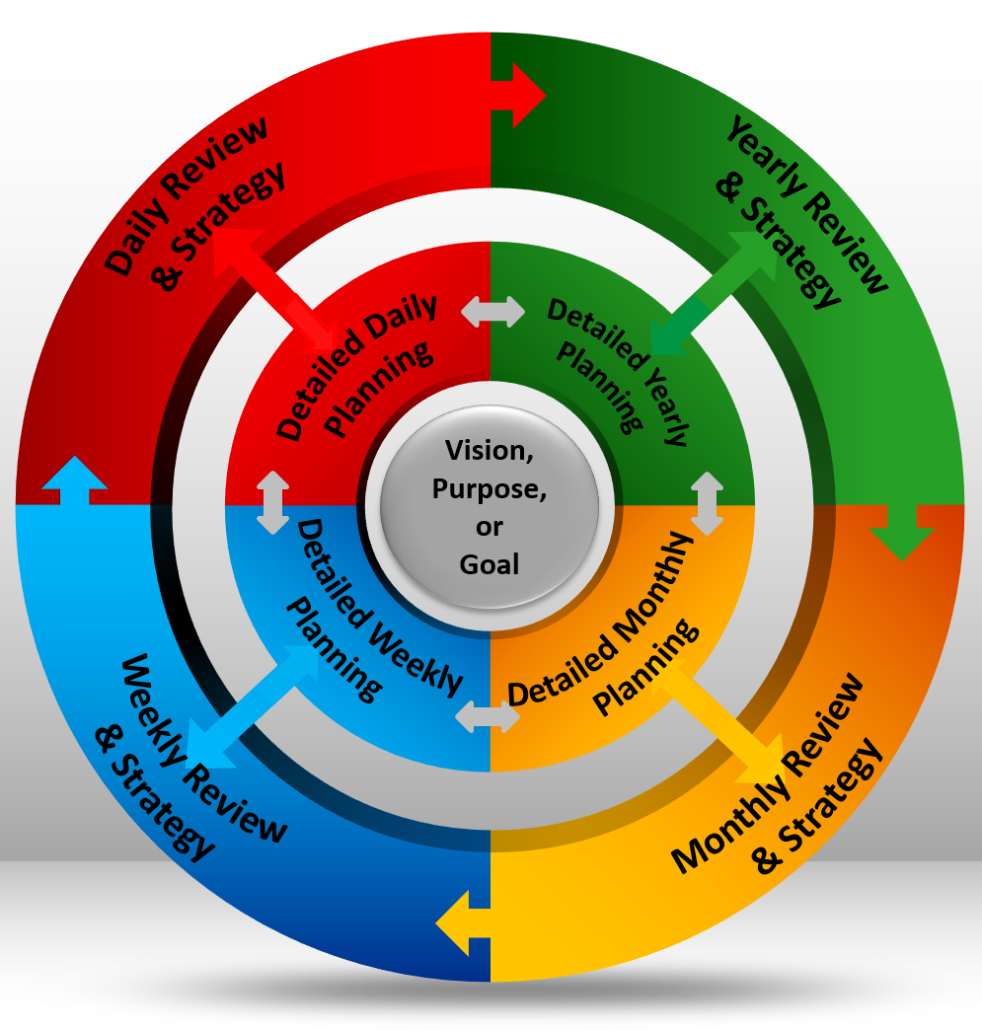Every business leader must have a rock solid organizational system in place so that they can lead a differentiated business. Failure to differentiate yourself results in a race for the bottom!

In a last week’s post I wrote about how a differentiated leader must have instant access to all of their past and current business notes, data, ideas, and plans. I mentioned that all of this information must be organized and indexed electronically in a manner that allows easy access from anywhere, at anytime, using any platform. Finally, I stated that this is not a product but a system that contains two distinct elements:
- a cloud based software tool (see last week’s post for more details)
- a systematic approach to organization for an effective business leader
This week we will focus on a systematic approach to organization that will help you become an effective and focused business leader!
The Effective and Focused Business Leader
In early 2000, I was facing a huge workload and a ton of change. Due to circumstances in our business, I was:
- Going through the pains of an acquisition after the company I worked at was purchased
- Running a mega project which was a first for me and our business
- Given responsibility for running an office in another world area
- Working on growing a new account with a very large customer
- Traveling a lot internationally
Because of the nature of this workload, there were times that I was overwhelmed and completely overworked. I was in need of a good mentor and a system that would help me focus and prioritize properly.
Fortunately, I found both!
I happened to take a weekend class taught by Les Hewitt, the author of The Power of Focus. I learned a ton from the class and from his book. In addition, Les gave me some great one on one coaching. I was able to take what I learned from Les and couple it with some training I took from Peter Drucker’s Graduate School of Management and build a system that helped me meet and overcome the challenges that I faced. For the purposes of this post, I will simply call it D.O.S. – Dave’s Organization System!
D.O.S. – Dave’s Organization System!
I follow this system very closely but I also tweak it continuously whenever I find something that I think will add value to me or the businesses that I run. The system is quite simple but very powerful. It consists of four main activities listed below and also shown in the diagram:
- Yearly Review and Strategy Planning
- Monthly Review and Strategy Planning
- Weekly Review and Strategy Planning
- Daily Review and Strategy Planning
I describe each component in detail below.
Yearly
A business leader needs to take time out of their schedule once a year for some deep reflection and strategic planning. Although this post is focused specifically on business, these times of reflection and planning should cover all areas of a person life; finances, health and wellness, family, personal, etc.
I like to take at least a day and review the past year, the current market situation and my vision for the organization moving forward. This is done at the end of the financial year for the organization that I am running.
This review and reflection is used to:
- Survey the market and understand the forces that may impact the business
- Adjust the strategic plan that I have for the business
- Set up new goals for the next 12 months. Depending on your industry, you may have a longer outlook than 12 months (I have done 3, 5 and 10 year plans in the past) but in today’s fast paced world, a 12 month window is what seems to work best.
- Break the one year goals into a plan and activities that fit nicely into each of the 12 months of the year.
- I make sure to use the SMART goal setting process for this so I know exactly what I need to accomplish and I can easily measure monthly progress against the goals.
- I add calendar blocks for critical activities so that these activities get the priority they require
- If there are any ideas or activities that are important but don’t yet fit into my strategy and plans, I make sure that I record them in my Actions notebook (see last week’s post for details)
Monthly
At the end of each month, I set aside a few hours to review the month in detail and to understand:
- Exactly what I accomplished against my plan for the month and the year to date
- The status of the overall business
- Changes in the market that may impact my strategy and goals or make them irrelevant
- Any market changes that may impact my strategy and goals and make them more relevant
- Any changes that require adding entirely new goals and focus
I use this time of reflection and the information that I gather to:
- Adjust my strategy if required
- Re-allocate resources to the areas that they are needed most
- Set up my goals for the upcoming month making sure they are in alignment with my overall strategy for the business.
- I break these goals into weekly targets so that it is clear to me what has to be done each week
- I add calendar blocks for critical activities so that these activities get the priority they need
- If there are any ideas or activities that are important but don’t yet fit into my strategy and plans, I make sure that I record them in my Actions notebook (see last week’s post for details)
Weekly
Every Friday, before I head out for the weekend, I take 30 minutes to:
- Review the week and understand the progress that was made against all of my activities, tasks and goals.
- Take a look at the month and ensure that I am on track for hitting the monthly targets
- Analyse the planned activities for the next week
- Adjust and add any additional calendar blocks for focus time, meetings, or supporting activities that I may need to achieve goals and targets
- Build my daily Action Plan for Monday (see previous post for details)
- If there are any ideas or activities that are important but don’t yet fit into my strategy and plans, I make sure that I record them in my Actions notebook (see last week’s post for details)
Daily
At the end of each day I take 15 minutes to:
- Review my day and understand the progress that was made during the day
- Take note of any areas that require more attention
- Review the planned activities for the next day
- Adjust my calendar blocks if required
- Build my daily Action Plan for the following day (see previous post for details)
- If there are any ideas or activities that are important but don’t yet fit into my strategy and plans, I make sure that I record them in my Actions notebook (see last week’s post for details)
A solid organizational system starts with having a long term purpose, focus, vision or goal. Once you have this focus established, the process to build this into a something that you can deliver is very simple. You always start with the end in mind and break the goal into bite sized pieces. What you do each day determines your weekly success. What you do each week determines your monthly success and what you do each month determines your yearly success.
Pretty simple yet very powerful!
Take Action
Obviously building a system like this takes time, effort and discipline. Coupling a system like this with a tool like OneNote in a way that I described last week will position you to be a powerful, effective, focused, and differentiated business leader!
My challenge to you is to take the time to build a system that works for you and differentiate yourself and your business!
Get started today by downloading the infographic for this post (click on the Business Tools and scroll down to “Organization System Infographic”) and reading at these related articles:
- How to Prepare Yourself for Exponential Growth
- How to Use Powerful Goals to Ignite Your Business
- How to Build a Powerful Business Strategy
- What You Can Learn About Business from Mountain-Biking
“Plan your progress carefully; hour-by hour, day-by-day, month-by-month. Organized activity and maintained enthusiasm are the wellsprings of your power.” Paul J. Meyer
Leave a comment below on what you use for an organization system and planning process.
Download a free copy of my new Ebook: 12 Steps to Business Transformation. If you would like a business assessment to help kick off your business transformation, contact me at info@thinkingbusinessblog.com or at 587-227-5179.
Be sure to sign up at www.thinkingbusinessblog.com for weekly blog updates delivered to your inbox.


Please note: I reserve the right to delete comments that are offensive or off-topic.